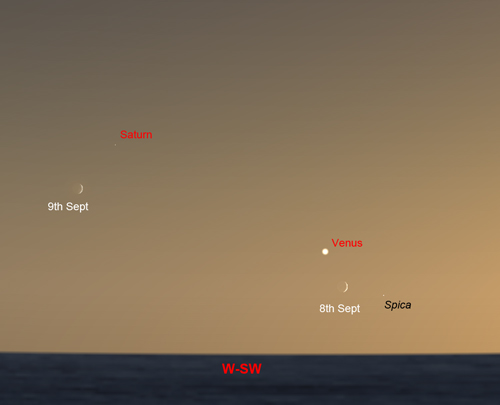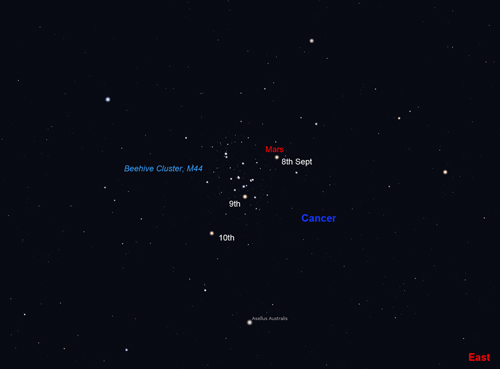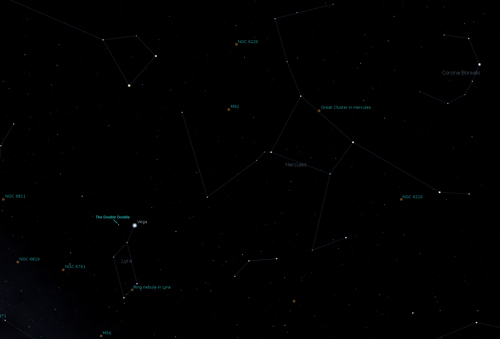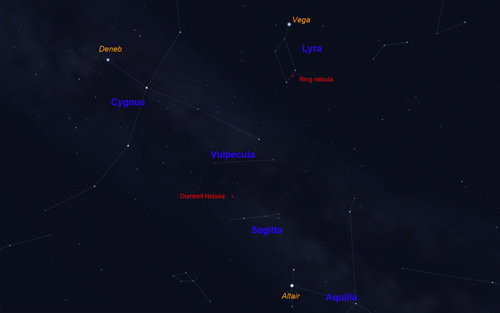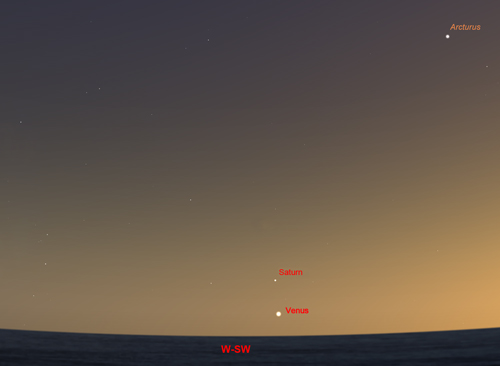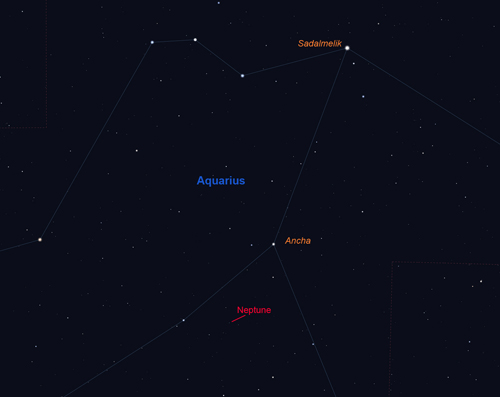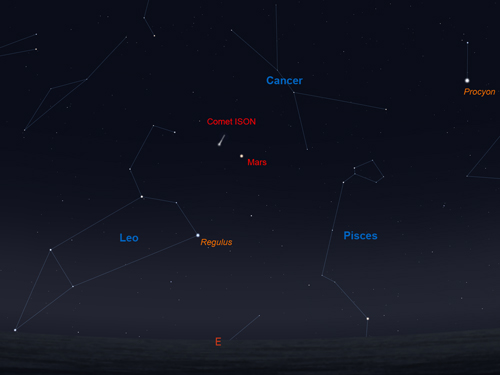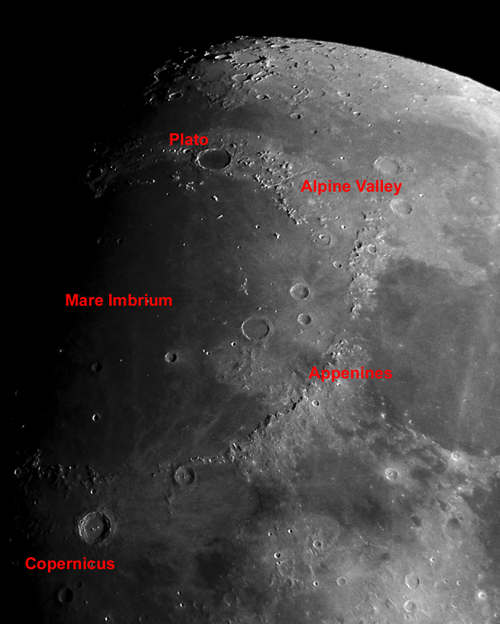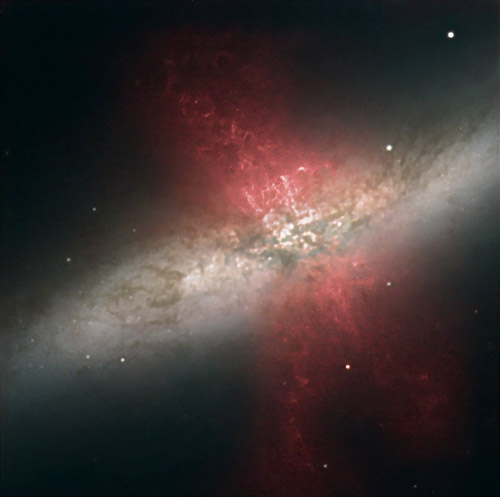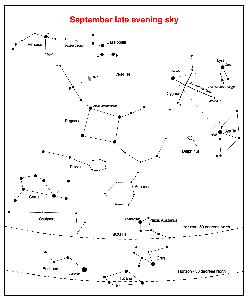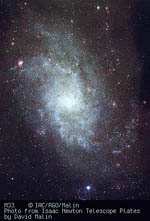The Night Sky September 2013
Compiled by Ian Morison
This page, updated monthly, will let you know some of the things that you can look out for in the night sky. It lists the phases of the Moon, where you will see the naked-eye planets and describes some of the prominent constellations in the night sky during the month.
Image of the Month
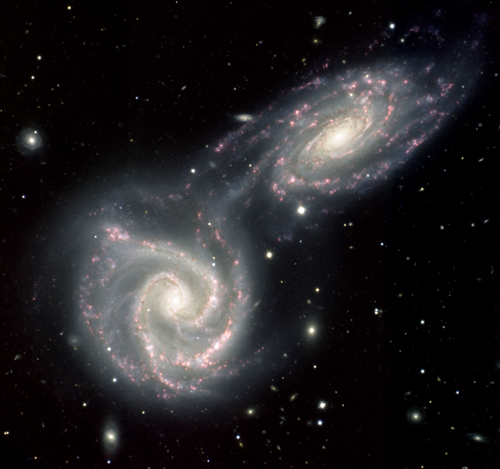
Colliding Galaxies
Image: Gemini Observatory, GMOS-South, NSF
This image is of two colliding galaxies, NGC 5426 and NGc 5427 known collectively as Arp 271. It was taken by the 8-metre Gemini-South Telescope in Chile and shows a bridge of material conecting the two spiral galaxies. They lie about 90 million light years away and span about 130,000 light years across. Both galaxies are somewhat smaller than our own Milky Way galaxy which will undergo a similar interaction with the Andromeda galaxy in a few billion years.
Highlights of the Month
September 8th and 9th - after sunset : Saturn and Venus along with a thin crescent Moon
About 45 minutes after sunset on the 8th and given a low horizon in the west-southwest it should be possible to observe Venus just over two degrees to the upper left of a thin crescent Moon. Saturn lies just over 11 degrees away slightly up to the left. On the following night the waxing crescent Moon will lie just over three degrees to the lower left of Saturn.
September 8th,9th and 10th: Mars crosses the Beehive Cluster in Cancer
Just before dawn on the mornings of the 8th, 9th and 10th, Mars will be seen passing across the Beehive Cluster, M44, in Cancer giving a nice telescopic imaging opportunity. Mars will be shining at magnitude 1.6 whilst the brightest stars in the cluster are around magnitude 6 to 7 so it will stand out well. Binoculars will probably be needed to view Mars' passage but please cease using them after sunrise.
September - Find the globular cluster in Hercules and spot the "Double-double" in Lyra
There are two very nice objects to spot with binoculars in the southern sky after dark this month. Two thirds of the way up the right hand side of the 4 stars that make up the "keystone" in the constellation Hercules is M13, the best globular cluster visible in the northern sky. Just to the left of the bright star Vega in Lyra is the multiple star system Epsilon Lyrae often called the double-double. With binoculars a binary star is seen but, when observed with a telescope, each of these two stars is revealed to be a double star - hence the name! More details can be found within the "Astronomical A-List" (Link is at upper left.)
September - Use a telescope to view two of the best planetary nebula in the northern sky - The Ring and Dumbbell Nebulae in Lyra and Vulpecular respectivly.
When it gets dark during September the beautiful region of the sky including Cygnus, Lyra and Aquilla will be high in the south. The constellations brightest stars: Vega in Lyra, Deneb in Cygnus and Altair in Aquila making up what is called the summer triangle. Within this region lie two of the brightest planetary nebulae that we can observe in the northern skies. Between Beta and Gamma Lyrae, the pair of bright stars lying below Vega, is the Ring Nebula, M57, seen as a tiny "smoke ring" in a small telescope whilst, below Cygnus in Vulpecula is the Dumbbell Nebula, M27. M27 can even be seen with 10 x 50 binoculars given a dark, transparent, sky. Details of both these beautiful objects can be found within the "Astronomical A List" section of our website (link at upper left) or within the author's book "Pocket Guide to Stars and Galaxies" for which the list was initially produced.
September 17th - one hour after after sunset : Saturn lies above Venus in the darkening sky.
About one hour after sunset on the 17th and given a low horizon in the west-southwest it should be possible to observe Saturn at +0.7 magnitudes just 3.5 degrees above Venus - much brighter at magnitude -4.1.
September - A good month to observe Neptune with a small telescope.
Neptune came into opposition - when it is nearest the Earth - on the 27th of August, so will be seen well in the late evening this month. Its magnitude is +7.9 so Neptune is easily spotted in binoculars lying in the constellation Aquarius as shown on the chart. It rises to an elevation of ~27 degrees when due south. Given a telescope of 8 inches or greater aperture and a dark tranparent night it should even be possible to spot its moon Triton.
September - Comet ISON should become visible in a medium sized telescope and will lie 2 degrees above Mars on the 27th
Before dawn towards the end of the month and given a 6" or greater telescope, it may be possible to spot comet ISON which will then have a predicted magnitude of +10. However, recently it has not been brightening as much as predicted and, when observed on August 12th, had a magnitude of 14.3 rather than its predicted magnitude of between 12.3 and 13.5. Sadly, this might mean that ISON will not be the spectacular comet that many had hoped for. On the 27th, it will lie just two degrees above the planet Mars which had just crossed into Leo from Cancer. This page will try to keep you updated as the weeks progress. The app "SkySafari Plus" for ipad and android devices will download the comets orbital elements and show its position in the sky.
September: 14th and 26/27th: The Alpine Valley
An interesting valley on the Moon: The Alpine Valley
These are good nights to observe an interesting feature on the Moon if you have a small telescope. Close to the limb is the Appenine mountain chain that marks the edge of Mare Imbrium. Towards the upper end you should see the cleft across them called the Alpine valley. It is about 7 miles wide and 79 miles long. As shown in the image a thin rill runs along its length which is quite a challenge to observe. Over the next two nights following the 3rd/4th the dark crater Plato and the young crater Copernicus will come into view. This is a very interesting region of the Moon!
A Messier Object imaged with the Faulkes Telescope: M82 in Ursar Major
Galaxy M82, imaged by Daniel Duggan.
This image was taken using the Faulkes Telescope North by Danial Duggan - for some time a member of the Faulkes telescope team. Lying at at distance of 12 million light years in the constellation Ursa Major, it makes a pair with M81. Tidal interactions between them have initiated a "burst" of star formation hence it is called a "starburst" galaxy. At its heart, one star becomes a supernova every 30 years or so and their evolution is being studied by radio telescopes such as the Jodrell Bank MERLIN array and the European VLBI network that can image the expanding shell of gas resulting from the stellar explosions.
Learn more about the Faulkes Telescopes and how schools can use them: Faulkes Telescope"
Observe the International Space Station

The International Space Station and Jules Verne passing behind the Lovell Telescope on April 1st 2008.
Image by Andrew Greenwood
Use the link below to find when the space station will be visible in the next few days. In general, the space station can be seen either in the hour or so before dawn or the hour or so after sunset - this is because it is dark and yet the Sun is not too far below the horizon so that it can light up the space station. As the orbit only just gets up the the latitude of the UK it will usually be seen to the south, and is only visible for a minute or so at each sighting. Note that as it is in low-earth orbit the sighting details vary quite considerably across the UK. The NASA website linked to below gives details for several cities in the UK. (Across the world too for foreign visitors to this web page.)
Note: I observed the ISS three times recently and was amazed as to how bright it has become.
Find details of sighting possibilities from your location from: Location Index
See where the space station is now: Current Position
The Moon

The Moon at 3rd Quarter. Image, by Ian Morison, taken with a 150mm Maksutov-Newtonian and Canon G7.
Just below the crator Plato seen near the top of the image is the mountain "Mons Piton". It casts a long shadow across the maria from which one can calculate its height - about 6800ft or 2250m.
| new moon | first quarter | full moon | last quarter |
|---|---|---|---|
| September 5th | September 12th | September 19th | August 27th |
Some Lunar Images by Ian Morison, Jodrell Bank Observatory: Lunar Images
A World Record Lunar Image
To mark International Year of Astronomy, a team of British astronomers have made the largest lunar image in history and gained a place in the Guinness Book of Records! The whole image comprises 87.4 megapixels with a Moon diameter of 9550 pixels. This allows details as small as 1km across to be discerned! The superb quality of the image is shown by the detail below of Plato and the Alpine Valley. Craterlets are seen on the floor of Plato and the rille along the centre of the Alpine valley is clearly visible. The image quality is staggering! The team of Damian Peach, Pete lawrence, Dave Tyler, Bruce Kingsley, Nick Smith, Nick Howes, Trevor Little, David Mason, Mark and Lee Irvine with technical support from Ninian Boyle captured the video sequences from which 288 individual mozaic panes were produced. These were then stitched together to form the lunar image.
Please follow the link to the Lunar World Record website and it would be really great if you could donate to Sir Patrick Moore's chosen charity to either download a full resolution image or purchase a print.
The Planets
Jupiter is now well placed in the pre-dawn sky at the start of an excellent apparition along with Neptune which reached opposition on August 28th as described in one of the month's highlights.
Jupiter
Jupiter rises about 01:00 BST at the beginning of September and, at the start of astronomical twilight, is 25 degrees above the horizon in the south-east shining at magnitude -2 with a disk ~35 arc seconds across and lying in the constellation Gemini. By month's end Jupiter rises at 11:30 BST and will be at an elevation of 50 degrees before dawn breaks with a magnitude of -2.2 and diameter of 37.5 arc seconds. A small telescope should be able to image the four Gallilean moons as they weave their way around it with, at times, the Great Red Spot visible on the surface. Nicely, both equatorial bands are showing well at the present time.
Saturn
Saturn, lying in Libra, is now well past opposition so will be seen low in the south-west after sunset. Saturn's magnitude remains at +0.7 during the month, whilst its angular size decreases a little from 16.1 to 15.6 arc seconds. The rings have opened out to ~17 degrees from the line of sight and we are now observing the planet's southern hemisphere whilst much of the northern hemisphere will be hidden by the rings. As this month it can only be seen at a low elevation, telescopic views will not be good, but with a small scope it should still be possible to spot Saturn's largest moon, Titan. Saturn is now lying in the more southerly part of the ecliptic so, even at opposition, its elevation does not get that high when seen from our northern latitudes. Sadly, this will get worse for quite a number of years to come.
See the highlight above
Mars
Mars starts September in Cancer but, moving quickly across the sky, moves into Leo on the 25th. Shining at magnitude +1.6 it rises about 03:00 BST will lie about 12 degrees above the north-eastern horizon by 04:30 BST as darkness begins to end. It will be easily visible in binoculars in the pre-dawn sky - but please cease using them at sunrise! Its magnitude of +1.6 remains constant during the month with its angular size increasing a little from 4.1 to 4.4 arc seconds so markings are unlikly to be seen on its salmon-pink surface.
See the highlight above
Mercury
Mercury. In late September, Mercury might be seen just above the horizon about half an hour after sunset down to the lower right of Venus and Saturn. It will be hard to see when using binoculars or a telescope even given its magnitude of ~-0.1.
Venus
Venus can be seen low above the horizon in the west-southwest after sunset as its brightness brightens from -4.0 to -4.2 magnitudes. Its angular size increases during the month from 15 to 18 arc seconds as the percentage of the disk that is illuminated decreases from 74 to 64%. It is an interesting fact that during its long apparition its brightness hardly changes as when it is further away from Earth more of its smaller disk is illuminated by the Sun.
See the highlight above
Find more planetary images and details about the Solar System: The Solar System
The Stars
The Evening September Sky
This map shows the constellations seen towards the south in late evening. To the south in early evening moving over to the west as the night progresses is the beautiful region of the Milky Way containing both Cygnus and Lyra. Below is Aquilla. The three bright stars Deneb (in Cygnus), Vega (in Lyra) and Altair (in Aquila) make up the "Summer Triangle". East of Cygnus is the great square of Pegasus - adjacent to Andromeda in which lies M31, the Andromeda Nebula. To the north lies "w" shaped Cassiopeia and Perseus.
The constellations Lyra and Cygnus
This month the constellations Lyra and Cygnus are seen almost overhead as darkness falls with their bright stars Vega, in Lyra, and Deneb, in Cygnus, making up the "summer triangle" of bright stars with Altair in the constellation Aquila below. (see sky chart above)
Lyra
Lyra is dominated by its brightest star Vega, the fifth brightest star in the sky. It is a blue-white star having a magnitude of 0.03, and lies 26 light years away. It weighs three times more than the Sun and is about 50 times brighter. It is thus burning up its nuclear fuel at a greater rate than the Sun and so will shine for a correspondingly shorter time. Vega is much younger than the Sun, perhaps only a few hundred million years old, and is surrounded by a cold,dark disc of dust in which an embryonic solar system is being formed!
There is a lovely double star called Epsilon Lyrae up and to the left of Vega. A pair of binoculars will show them up easily - you might even see them both with your unaided eye. In fact a telescope, provided the atmosphere is calm, shows that each of the two stars that you can see is a double star as well so it is called the double double!
Between Beta and Gamma Lyra lies a beautiful object called the Ring Nebula. It is the 57th object in the Messier Catalogue and so is also called M57. Such objects are called planetary nebulae as in a telescope they show a disc, rather like a planet. But in fact they are the remnants of stars, similar to our Sun, that have come to the end of their life and have blown off a shell of dust and gas around them. The Ring Nebula looks like a greenish smoke ring in a small telescope, but is not as impressive as it is shown in photographs in which you can also see the faint central "white dwarf" star which is the core of the original star which has collapsed down to about the size of the Earth. Still very hot this shines with a blue-white colour, but is cooling down and will eventually become dark and invisible - a "black dwarf"! Do click on the image below to see the large version - its wonderful!
M56 is an 8th magnitude Globular Cluster visible in binoculars roughly half way between Alberio (the head of the Swan) and Gamma Lyrae. It is 33,000 light years away and has a diameter of about 60 light years. It was first seen by Charles Messier in 1779 and became the 56th entry into his catalogue.
Cygnus
Cygnus, the Swan, is sometimes called the "Northern Cross" as it has a distinctive cross shape, but we normally think of it as a flying Swan. Deneb,the arabic word for "tail", is a 1.3 magnitude star which marks the tail of the swan. It is nearly 2000 light years away and appears so bright only because it gives out around 80,000 times as much light as our Sun. In fact if Deneb where as close as the brightest star in the northern sky, Sirius, it would appear as brilliant as the half moon and the sky would never be really dark when it was above the horizon!
The star, Albireo, which marks the head of the Swan is much fainter, but a beautiful sight in a small telescope. This shows that Albireo is made of two stars, amber and blue-green, which provide a wonderful colour contrast. With magnitudes 3.1 and 5.1 they are regarded as the most beautiful double star that can be seen in the sky.
Cygnus lies along the line of the Milky Way, the disk of our own Galaxy, and provides a wealth of stars and clusters to observe. Just to the left of the line joining Deneb and Sadr, the star at the centre of the outstretched wings, you may, under very clear dark skys, see a region which is darker than the surroundings. This is called the Cygnus Rift and is caused by the obscuration of light from distant stars by a lane of dust in our local spiral arm. the dust comes from elements such as carbon which have been built up in stars and ejected into space in explosions that give rise to objects such as the planetary nebula M57 described above.
There is a beautiful region of nebulosity up and to the left of Deneb which is visible with binoculars in a very dark and clear sky. Photographs show an outline that looks like North America - hence its name the North America Nebula. Just to its right is a less bright region that looks like a Pelican, with a long beak and dark eye, so not surprisingly this is called the Pelican Nebula. The photograph below shows them well.
Brocchi's Cluster An easy object to spot with binoculars in Gygnus is "Brocchi's Cluster", often called "The Coathanger",although it appears upside down in the sky! Follow down the neck of the swan to the star Alberio, then sweep down and to its lower left. You should easily spot it against the dark dust lane behind.
The constellations Pegasus and Andromeda
Pegasus
The Square of Pegasus is in the south during the evening and forms the body of the winged horse. The square is marked by 4 stars of 2nd and 3rd magnitude, with the top left hand one actually forming part of the constellation Andromeda. The sides of the square are almost 15 degrees across, about the width of a clentched fist, but it contains few stars visibe to the naked eye. If you can see 5 then you know that the sky is both dark and transparent! Three stars drop down to the right of the bottom right hand corner of the square marked by Alpha Pegasi, Markab. A brighter star Epsilon Pegasi is then a little up to the right, at 2nd magnitude the brightest star in this part of the sky. A little further up and to the right is the Globular Cluster M15. It is just too faint to be seen with the naked eye, but binoculars show it clearly as a fuzzy patch of light just to the right of a 6th magnitude star.
Andromeda
The stars of Andromeda arc up and to the left of the top left star of the square, Sirra or Alpha Andromedae. The most dramatic object in this constellation is M31, the Andromeda Nebula. It is a great spiral galaxy, similar to, but somewhat larger than, our galaxy and lies about 2.5 million light years from us. It can be seen with the naked eye as a faint elliptical glow as long as the sky is reasonably clear and dark. Move up and to the left two stars from Sirra, these are Pi amd Mu Andromedae. Then move your view through a rightangle to the right of Mu by about one field of view of a pair of binoculars and you should be able to see it easily. M31 contains about twice as many stars as our own galaxy, the Milky Way, and together they are the two largest members of our own Local Group of about 3 dozen galaxies.
M33 in Triangulum
If, using something like 8 by 40 binoculars, you have seen M31 as described above, it might well be worth searching for M33 in Triangulum. Triangulum is
the small faint constellation just below Andromeda. Start on M31, drop down to Mu Andromedae and keep on going in the same direction by the same distance as you have moved from M31 to Mu Andromedae. Under excellent seeing conditions (ie., very dark and clear skies) you should be able to see what looks like a little piece of tissue paper stuck on the sky or a faint cloud. It appears to have uniform brightness and shows no structure. The shape is irregular in outline - by no means oval in shape and covers an area about twice the size of the Moon. It is said that it is just visible to the unaided eye, so it the most distant object in the Universe that the eye can see. The distance is now thought to be 3.0 Million light years - just greater than that of M31.


